Get out: The rise and rise of queer horror
A few years ago, screenwriter Alyson Richards decided she'd seen enough horror movies in which lesbian characters are revealed to be psychotic killers.
"I remember watching High Tension, which is great, [but] at the end, the big twist, is, like: crazy lesbian!" says Richards. "And then there was another movie called What Keeps You Alive — really solid film, but the twist was: One of the women in the relationship is actually a killer! I was finding that queer characters in horror, and particularly women, had two destinations. It was either getting murdered or being the psychotic killer."
This realization prompted Richards to write last year's indie-horror film The Retreat. Directed by Pat Mills, the film follows a lesbian couple, Renee (Tomee-Amber Pirie) and Valerie (Sarah Allen), who are menaced by homophobic killers during a weekend away at a remote house.
"My wife and I stayed in this cabin in rural Australia," says Richards. "It was so beautiful and serene, but there were a couple of elements that were a little bit off. One day, this basket of baked goods showed up at the front door, and I picked it up, and it was covered it bugs. It was this nice gesture but was kind of creepy. That was the beginning of the idea. It was taking that fear that queer people have outside the comfort of the urban environment and spinning it with what the worst case scenario would be."
The Retreat's killer twist? (Spoiler alert!) Neither of the film's protagonists turn out to be psychos.
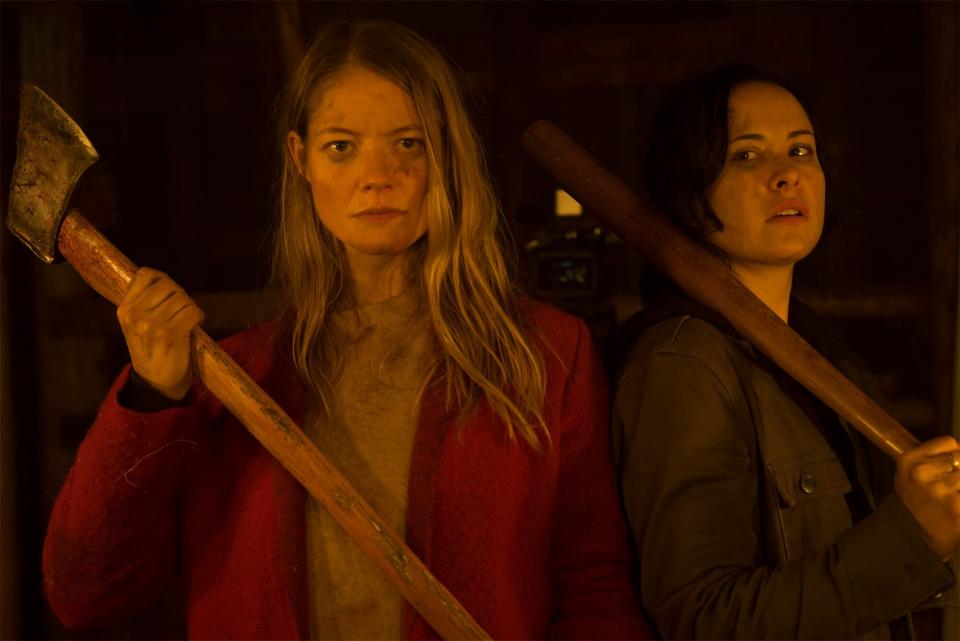
Quiver Distribution 'The Retreat'
The Retreat is one of several recent films, many of them from queer creators, which push against the stereotypical depiction of LGBTQ+ characters in the horror genre. Other examples include The Perfection, Knife + Heart, the Vince Vaughn-starring Freaky, Palme d'Or winner Titane, Netflix's The Fear Street Trilogy, and the latest installment of Scream, in which Jasmin Savoy Brown plays the franchise's first openly gay character.
Plus, there are more on the way: In Hypochondriac (out in theaters July 29) Zach Villa plays a gay potter starts to see a terrifying creature after he is contacted by his mentally unwell mother. Gladiator screenwriter John Logan's directorial debut They/Them (out on Peacock August 6) stars Theo Germaine as a nonbinary transgender teenager forced to attend a gay-conversion camp where people are being picked off by a masked killer. Meanwhile, filmmaker Carter Smith's new movie Swallowed (which screened at the recent Overlook Festival) concerns a young gay man whose attempt to smuggle drugs goes horribly awry. Like Alyson Richards, both Logan and Smith deliberately set out to make films which frightened viewers while also centering on positive queer characters in a manner they rarely, if ever, saw in horror.
"When I was growing up, gay characters were either victims or they were jokes," says Logan. "I know how much it would have meant to me as a 12-, 13-, 14-year-old to see a queer hero in a horror film, and so I wanted to write that."
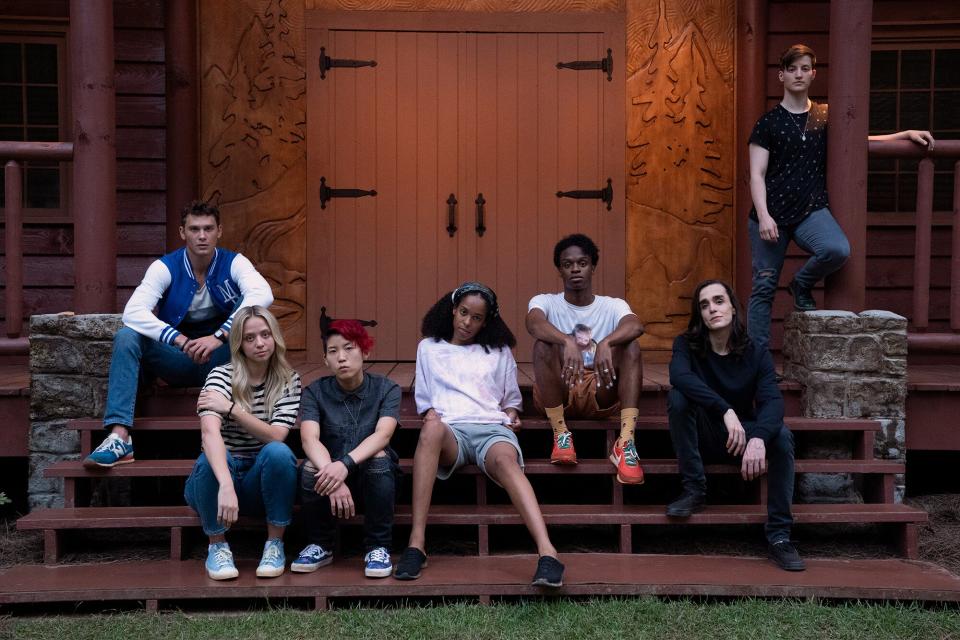
Josh Stringer/Blumhouse 'They/Them'
"One of the things that I feel you don't see, at least in the genre that I love so much, is work about queer characters where the story isn't necessarily about their queerness," says Swallowed's Smith, best known for directing the 2008 horror movie The Ruins. "I really wanted to tell a story that I wish I'd had when I was 15 and desperate to see myself in the films that I loved."
The arrival of these films is part of a multi-platform rise in queer horror. Over the past decade, TV shows like Hannibal, The Walking Dead, and American Horror Story have all featured prominent queer characters. Most recently, the first season of Chucky hinged around a gay teenager and his battles with the titular killer doll. "Each iteration of Chucky has gotten a lot more personal and autobiographical for me," says Don Mancini, creator of the Chucky character and an executive producer on the show, "to a point where I'm able to use the character of Jake Wheeler as a figure for dealing with a lot of the things that I had to deal with as a young gay kid."
There has also been a proliferation of podcasts that examine horror through a queer lens. "We've seen an explosion," says Joe Lipsett, who has been co-hosting the Horror Queers podcast with Trace Thurman since 2019. "Initially, our first year, there were, like, five queer horror podcasts. Now there's nearly thirty of us."
Horror and queer culture have merged to gory and glamorous effect on The Boulet Brothers' Dragula, a reality competition TV show; its fourth season premiered on the streaming service Shudder last year. Co-hosted by Dracmorda Boulet and Swanthula Boulet, the show finds contestants both undertaking terrifying tasks and creating horror-themed costumes under the pair's watchful, contact-lens-enhanced gaze.
"Dragula celebrates everything that we love about horror," says Swanthula Boulet. "It can be scary but it can also be fun. Ultimately, it's a celebration of all things glamour, other, freaky, strange."
Shudder is further acknowledging the importance of queer horror with a four-part documentary series on the subject called Queer for Fear, executive-produced by Hannibal creator Bryan Fuller. It premieres in the fall.
"Shudder wanted to do a follow-up to Horror Noire, which is a fantastic documentary about the history of Black people in horror films," says Fuller. "It slowly evolved into less of a movie, like Horror Noire, and more of a series. It just seemed that the project is so sprawling. This really cannot be contained into an 80- or 90-minute narrative."
SO MANY WONDERFUL PEOPLE HAVE CONTRIBUTED TO THIS PROJECT. CAN’T WAIT TO SHARE IT WITH YOU. @Shudder #QUEERFORFEAR FACE BY @Alaska5000 LEWK BY @ChadEdwardEvett pic.twitter.com/CaI9SR0cg6
— Bryan Fuller (@BryanFuller) June 3, 2022
Fuller certainly has a lot of ground to cover, given the long relationship between horror cinema and queerness. James Whale, director of 1931's Frankenstein and 1935's Bride of Frankenstein, was an out gay man who larded his films with queer subtexts. From the early '30s on, the Hays Code proscribed "any inference of sex perversion," a category which included homosexuality, encouraging generations of queer cinemagoers (and later TV-watchers) to see themselves instead mirrored in the Universal Classic Monsters, particularly Whale's sympathetic depiction of Frankenstein's creature.
"Frankenstein, made by an openly gay director, celebrates the other, the outcast character, as the most sympathetic character in the movie," says They/Them director Logan. "There's no way you can watch Frankenstein, whether it's the 1930s or right now, and not be moved by Boris Karloff, moved by the creature. All the other characters [are] repellent or simplistic, but the creature is complex, trying to find his way as an outsider through a world that does not accept him. And if that is not the definition of being a queer person in many parts of this world, I don't know what it is."
The explosion of more violent, visceral, and outré horror films in the '70s and '80s led many young queer creators-in-the-making to explore the genre and ultimately make it their home. Bryan Fuller recalls being fascinated by Ridley Scott's Alien and its "penis-headed" monster while Chucky's Mancini remembers falling in love with the stylized and operatic films of Brian De Palma and Dario Argento.
Jeffrey Reddick, who created the Final Destination franchise, was attracted to the horror genre via slasher movies and, in particular, 1984's original Wes Craven-directed A Nightmare on Elm Street. "I grew up in eastern Kentucky and I was dealing with a lot of racism and homophobia," he says. "I wasn't out yet but I was just hearing it all around me. There was so much stuff that I could have internalized and made me a very rage-filled person, and I feel horror was a release valve for me. Horror let me let that fear out in a healthy way, by screaming and yelling and just exorcising a lot of stuff."
For Swallowed's Carter Smith, it was 1985's A Nightmare on Elm Street 2: Freddy's Revenge and actor Mark Patton's queer-coded hero which acted as a gateway to the world of big screen horror. "I think that it was probably the first time that I saw someone who I recognized myself in a little bit in a horror movie," says the director. Patton and his appearance in Freddy's Revenge would be the focus of a 2019 documentary, Scream Queen! My Nightmare on Elm Street, and Smith subsequently cast Patton as a queer drug dealer in Swallowed. "He stuck in my head, and then I saw Scream Queen!, and when I started writing the script, I specifically had him in mind," says the director.
Trans non-binary director Jane Schoenbrun, whose recently released-debut movie We're All Going to the World's Fair concerns a teenage girl's obsession with an online horror game, explains that they found comfort in the films of David Cronenberg. "I think trans people in general have planted their flag in the body horror genre, and I think there is good reason for that," they say. "We grow up with this complicated relationship to our own skin, and Cronenberg in all of his work creates a language to talk about that in a horrifying but also kind of beautiful way."
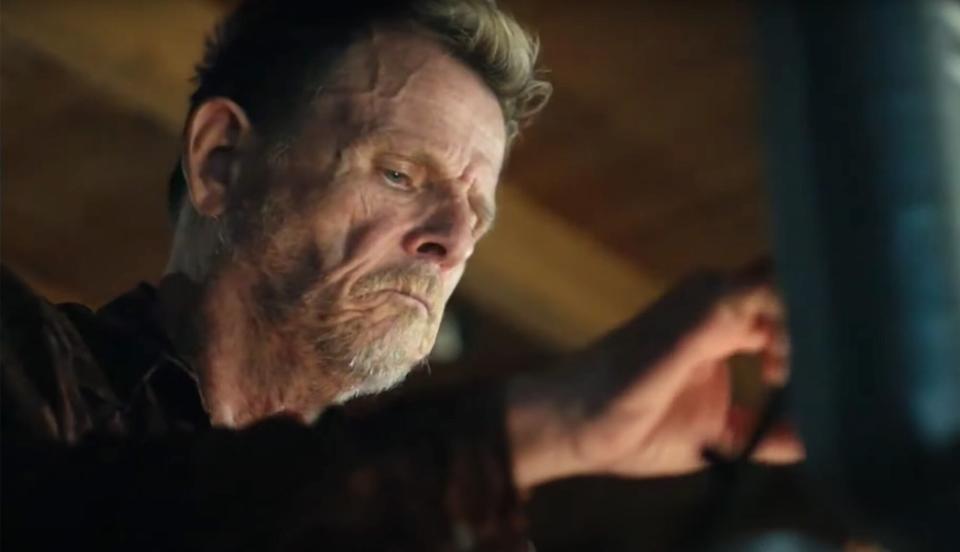
Mark Patton in 'Swallowed'
The love shown by the queer community for the horror genre has often seemed like a one-way street. Across entertainment, the habit of killing off queer characters has been so widespread, the trope has its own name: "burying your gays." Fictionally-speaking, the horror genre has slain many queer characters in films as diverse as 1972's Blacula, 1982's Argento-directed Tenebrae, 1984's The Toxic Avenger, and, more recently, 2019's It Chapter Two.
While queer viewers may have embraced relatively sympathetic monsters like Frankenstein or the Wolf Man, the LGBTQ+ community strongly protested Ted Levine's depiction of the chillingly monstrous cross-dressing killer Buffalo Bill in Jonathan Demme's 1991 horror-thriller Silence of the Lambs. In the film, Anthony Hopkins' Hannibal Lecter explains to Jodie Foster's Clarice Starling that "Billy's not a real transexual," but the movie provoked the ire of many. "The film is a continuation of Hollywood's appalling track record of portraying gays in negative ways...and could potentially encourage gay bashing," Richard Jennings, executive director of the Gay and Lesbian Alliance Against Defamation, told The Los Angeles Times after the film's release. "It also ignores the reality that most violence against women is committed by heterosexual males."
John Logan admits that the queer community's affection for horror has not always been reciprocated. "I love horror, I cut my teeth on it," says the three-time Oscar nominee, whose early credits included the 1999 genre movie Bats. "But it's a really problematic genre for gender, for sexual identifications, for sexual politics. It's very complicated and it always has been." According to Logan, there would have been little chance of him persuading a studio to green-light They/Them at an earlier point in Hollywood history. "No one would have done it," he says. "The idea that 20 years ago, someone would have said, 'Hey, let's embrace a trans, non-binary protagonist and let's embrace seven queer kids as our heroes' — that would have been so transgressive and so rebellious, just the idea of it would have been impossible. I was writing in Hollywood 20 years ago, and I know what the sensibility was toward alternate material."
The horror boom which followed the box office success of John Carpenter's original 1978 Halloween and 1980's Friday the 13th provided the opportunity for some filmmakers to smuggle homoeroticism into horror movies, particularly vampire tales like 1983's The Hunger, 1987's The Lost Boys (directed by queer auteur Joel Schumacher), and, of course, 1994's Tom Cruise-Brad Pitt fang-fest Interview with the Vampire. In 1987, Clive Barker unleashed the genre classic Hellraiser, it's leather-clad villains, the pain-loving Cenobites, partly inspired by S&M clubs the writer-director had visited in New York. Barker followed that three years later with the horror-fantasy Nightbreed, about a group of outcast monsters who create their own civilization. The queer allegory could hardly have been clearer. "Nightbreed is about outsiders and obviously, as a gay man, my outsiderness is in some measure to do with my homosexuality," Barker told this writer in 2014.
"Clive's movies left a deep mark on my young mind," says Dragula host Swanthula Boulet. "And then to later learn that he was a queer man himself, it sort of redefined what was possible."
The release of Scream in 1996 revived the horror genre as a whole after a period of doldrums. Screenwriter Kevin Williamson had been inspired by his feeling of connection with the plight of "final girls" like Heather Langenkamp's Nancy Thompson in A Nightmare on Elm Street and Jamie Lee Curtis' Laurie Strode in Halloween. "As a gay kid, I related to the final girl and to her struggle because it's what one has to do to survive as a young gay kid, too," Williamson told The Independent newspaper last year. "You're watching this girl survive the night and survive the trauma she's enduring. Subconsciously, I think the Scream movies are coded in gay survival."
Mancini joined in that moment with 1998's Bride of Chucky, the fourth film in his Child's Play franchise. He decided to point the series in a new direction by introducing a queer character (played by Gordon Michael Woolvett), casting Jennifer Tilly (an instant gay icon following her appearance in 1996's Bound) as Chucky's girlfriend, and encouraging filmmaker Ronny Yu and cinematographer Peter Pau to present the mayhem in a stylized manner largely absent from previous installments.
"I was in my early thirties when I wrote that," says Mancini. "I was at a point my life as a gay guy where I was fully out, and at the same time I was tasked with reinventing my franchise. So for me, it was partly: How do I keep this interesting? Well, how about having a gay character? That's new, that's fresh, we don't see that often, at least we didn't back in the '90s. It really wasn't initially motivated by any kind of activist impulse, it was really about just trying to find new stories to tell. The studio was very supportive of that and it seemed to go over well."
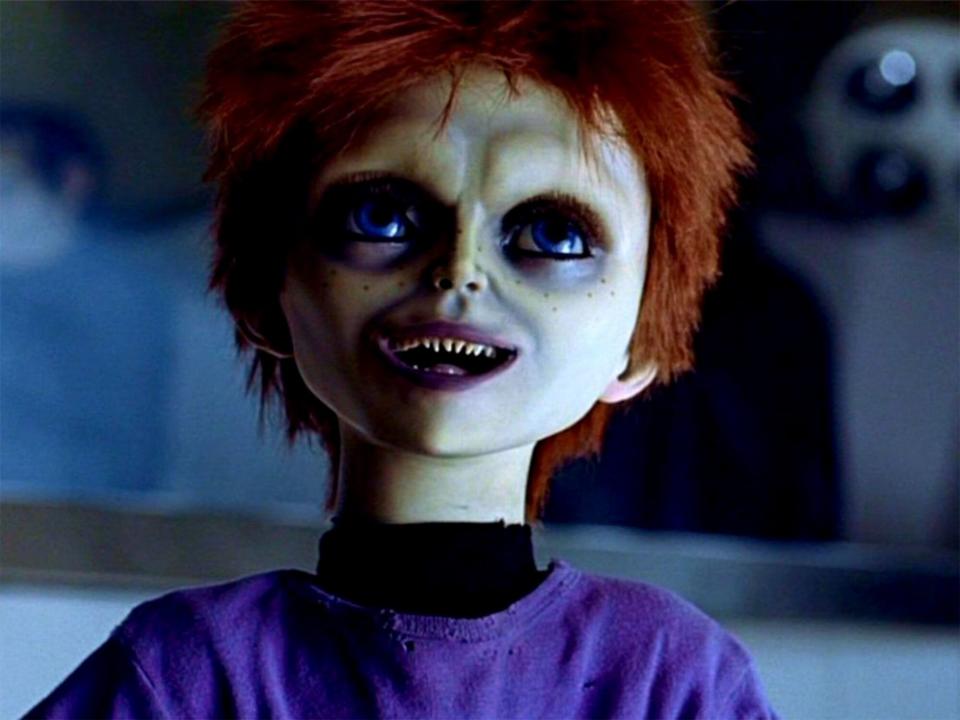
Rogue Pictures 'Seed of Chucky'
Horror films with queer themes would continue to be released in the years after Bride of Chucky, notably 2009's Jennifer's Body, a box office disappointment which would be reassessed and hailed as an essential queer text over time. But it was horror TV which led the way, with an array of shows from True Blood to American Horror Story to the John Logan-created Penny Dreadful.
"I think TV has been much more open, especially streaming TV, about trying to tell alternate stories," says Logan. "TV shows are like the Wild West. They go quick, they go fast, you can try things out, and the entire success of the show doesn't depend on it. So you can have more experimentation on TV, at least with the TV I've worked on."
"In the early aughts, we saw a shift in horror stories, in the cineplexes" says Fuller. "People were wanting the Hostels and the Saws so that created a space for queer expression in television. That was seeded with Tara and Willow in Buffy and then exploded with something like True Blood that said, okay, movie horror isn't as much fun anymore, and it's this serious kind of mean male tone, and we're going to bring the fun back to horror but we're going to do it in a television landscape."
Bryan Fuller's own Hannibal, which premiered in 2014 and ran for three seasons, was another queer-themed horror show and a skilled riposte to Silence of the Lambs with its highlighting of the homoerotic relationship between Hugh Dancy's Will Graham and Mads Mikkelsen's Hannibal Lecter.
"Bryan brought out a latent homoerotic subtext that existed between the characters of Hannibal and Will Graham, and he just ran with that," says Mancini, who worked as a writer and producer on Hannibal. "When I saw it, and I saw how new and fresh and re-inventive it was, I was amazed, and a big part of the reinvention was the homoeroticism. That really brought it to life."
Horror creatives hoping to foreground gay themes have also benefited from the arrival of production companies like Blumhouse and A24 that specialize in backing seemingly left-field genre projects. When John Logan finished his script for They/Them, the first executive he called was Blumhouse founder Jason Blum. "No one knew I was writing it — it was a complete labor of love," says Logan. "It came out in a passionate white hot streak and the first person I talked about it [with] was Jason Blum. I emailed him on Wednesday and said, 'Hey, I'm going to send you a script on Friday, could you read it over the weekend?' Which he did. Thank goodness he really enjoyed it."
This summer, A24 will release Bodies Bodies Bodies (out iAugust 5), another horror film which foregrounds queer characters. The film stars Amandla Stenberg and Maria Bakalova as a couple who gatecrash a party weekend with a rapidly rising bodycount. Like the film's other Gen Z characters — played by Pete Davidson and Rachel Sennott — the pair are depicted in a nuanced, if not always necessarily positive, fashion by director Halina Reijn, who uses the slasher genre to comedically dissect the performative, social-media-obsessed twentysomething lifestyle.
"The script plays with the hypocritical nature of the culture that we live in now, how there's a lot of virtue-signaling," Sternberg, who came out as gay in 2018, told EW earlier this year. "So many people don't do their actual research, so sometimes the nature of that virtue-signaling can feel so shallow. I think there's a lot of fodder for comedy there."
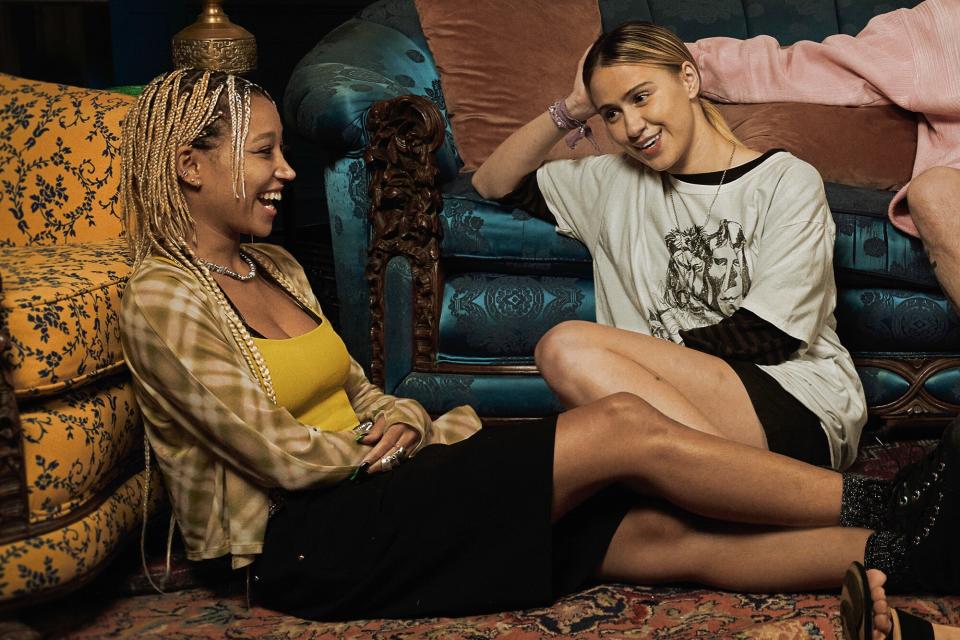
Eric Chakeen/A24 Amandla Stenberg and Maria Bakalova in A24's 'Bodies Bodies Bodies'
Australian writer-director Jennifer Kent did not plan on her horror film The Babadook becoming a queer text when the movie was released in 2014. But over time, the tale's titular top-hatted monster would achieve gay-icon status. As Karen Tongson, an associate professor of gender studies and English at USC, told the Los Angeles Times in 2017, "Someone was like, 'How could The Babadook become a gay film,' and the answer was readily available. He lives in a basement, he's weird and flamboyant, he's living adjacently to a single mother in this kind of queer kinship structure. For many LGBT people, that's what it feels like to be in your own families sometimes."
Kent herself responded to the character's unplanned elevation to gay icon status in 2019, the year that home video distributor Shout! Factory released a special rainbow-covered Blu-ray of The Babadook. "I'm still trying to work that one out…It's quite perplexing," Kent told EW's Nick Romano. "I feel it's really quite beautiful, but I still have no idea why. I mean, I kind of do. I guess he's an outsider of sorts."
Want more evidence of queer culture's increasing ease within the horror genre? Look no further than horror bible Fangoria, which put the Boulet Brothers on the cover of the magazine last year.
"It was a really big moment for us," says Dracmorda Boulet. "We've been fans of the magazine since we were children. Both of us would look through Fangoria when we were young, and look at all the monster movie make-up and take inspiration from it. So it was a full-circle moment to actually be on the cover of it after all those years."
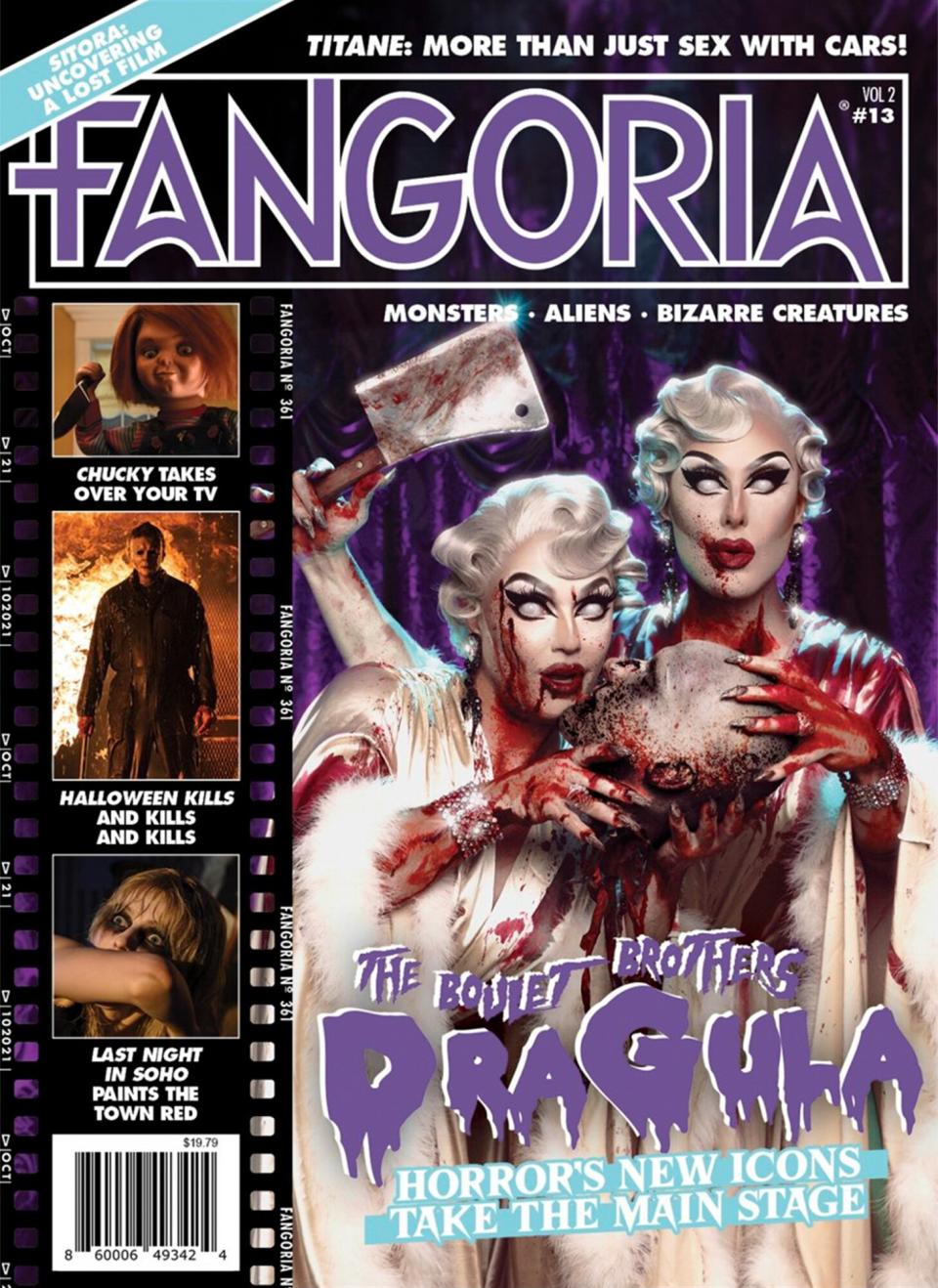
Boulet Brothers/Twitter The Boulet Brothers on the cover of Fangoria
The Boulet Brothers cover was the fastest-selling issue of Fangoria since the magazine was relaunched in 2018. "That meant a lot, because we weren't sure how people would take it," says Dracmorda Boulet. "There are a lot of old-school horror fans that aren't necessarily receptive to having drag artists on the cover of their favorite magazine."
It would be wrong to overstate the progress which has been made: Just a few years ago, Final Destination creator Jeffrey Reddick learned that an actor he wanted to cast in a horror film wouldn't take the role because the character was gay. "The frustrating part for me [was] the character didn't even kiss a guy, there wasn't any physicality," says Reddick. "[The actor, who Reddick won't name] killed it in the audition but his reps didn't want him playing a gay character. He was like, 'I've got to listen to my reps.' And I'm like, 'You don't even do anything gay!'"
Writer-director Jane Schoenburn's next film, I Saw the Glow, is about "two kids who grow up to have an intense relationship with a scary TV show from their youth." The movie is being produced by Fruit Tree, the production company set up by Emma Stone and her director-husband Dave McCary, which has a distribution deal with A24. Yet the director bridles slightly when asked if they feel more welcomed by the industry.
"I don't know if I would use the word 'welcome,'" they say. "When I'm bringing a new project into the world I am going into rooms exclusively made up of cis people. There are no trans people working in any kind of position of power in the independent or non-independent film space. It is something that, in five years, is an inevitability, just because the younger generation coming up will have a completely different relationship to gender than my generation of millennials and everyone above millennials. But it's completely, emotionally exhausting and politically treacherous as a trans artist, or any kind of minority artist working today, to carve out a path of creative autonomy in an industry that doesn't share your gaze or your life experience."
It is a thought with which Alyson Richards would surely agree. The Retreat screenwriter reveals that she had to fight long and hard to keep true to her vision of a film about a lesbian couple neither of whom turned out to be a villain.
"The Retreat was in development for a long time and we faced different obstacles at different times," recalls Richards. "It took a lot of time to raise money for it. The one big thing [we heard] was, 'Oh this is great, but you know what would be a great twist? What if one of the women was actually involved with the killers?' That came up so many times, I can't even tell you."
Watch trailers for The Retreat, They/Them, Swallowed, Bodies Bodies Bodies, and We're All Going to the World's Fair, below.
Sign up for Entertainment Weekly's free daily newsletter to get breaking TV news, exclusive first looks, recaps, reviews, interviews with your favorite stars, and more.
Related content:

 Yahoo Movies
Yahoo Movies 
